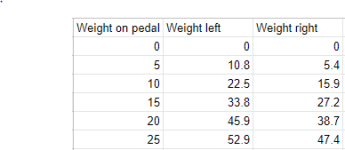mctubster said:Sorry to raise this again, but I am seeing Human Power readings that are way too high on alpha10.
Not sure if there was regression or maybe this was never solved?
I recall a discussion about peak vs averaged values - I had a look at the code, but I don't understand it ... can anyone comment on
// calculate torque on pedals
ui16_pedal_torque_x100 = ui16_adc_pedal_torque_delta * m_configuration_variables.ui8_pedal_torque_per_10_bit_ADC_step_x100;
Cheers
Have you looked at calibrating the torque sensor in the Advanced Setup? Does it help?
Because if it is properly calibrated in the low range it should show the actual human power. In the higher ranges, maybe above 25 kg for most users, it will not be linear and as a result the human power displayed will be much lower than expected.
The line of code you included is the calculation that converts the ADC value of the torque sensor to torque in newton meters. The m_configuration_variables.ui8_pedal_torque_per_10_bit_ADC_step_x100 is the conversion factor. It is this conversion factor you can change in the 0.20.0 firmware version when in the Advanced Setup calibrating the torque sensor.
Side note: we do not have to average the values. Our sampling rate is fast enough. We just continually measure and calculate the human power and then rely on filters.
Sorry for the late reply! And please let me know if you have more questions or if there is anything to improve or simplify!


